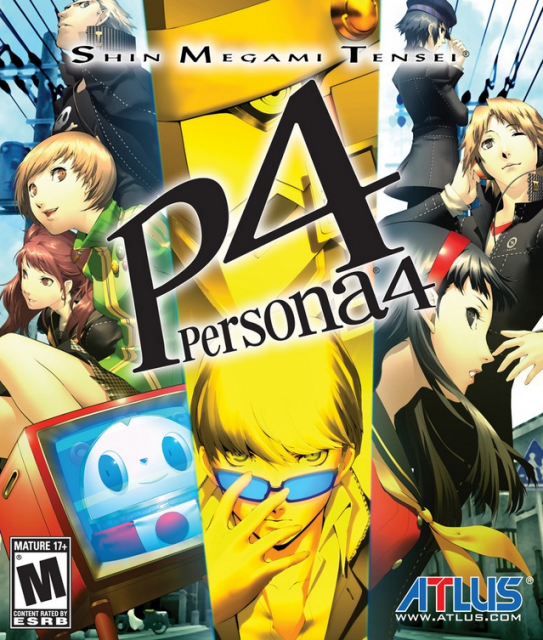A cohesive, enjoyable, and all around fantastic video game.
Often times, the end of a console’s life cycle is when some of its best games are made. After all, it is at this point when developers are most comfortable with how consoles work, allowing them to do more with what the system can put out than at any other point in a console’s run. A cursory glance at video game history bears this out: Panzer Dragoon Saga is both one of the best Sega Saturn games and one of its last; Conker’s Bad Fur Day was released very late in the Nintendo 64’s life; and this is certainly true of Shin Megami Tensei: Persona 4, a PlayStation 2 game released in 2008. From the intricate, thought-out story to the strangely tough battle system, Shin Megami Tensei: Persona 4 manages to do everything a great RPG should.
One of the more prominent reasons behind Persona 4’s success is its story, though not necessarily in its plot. On the surface, it appears to be a murder mystery, as a group of teenagers tries to figure out a recent string of murders/kidnappings, and on these grounds, it is not very good. After all, the suspects in the case play little role in the story outside their crimes, and the only information available to the player is that available to the characters, leaving little room for personal theories. Outside this, the story becomes nothing more than a series of disparate (if enjoyable) moments.
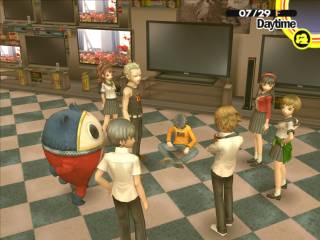
However, the plot is never meant to be viewed in this fashion; instead, its greatest strengths lie in its themes. This much is evident in the title itself: Persona. Generally, this refers to an alternate side of one’s self that they use to face everyday challenges. Although somewhat confusing at first, it eventually becomes clear that the writers put very much thought into it, along with just about everything else in the story. This much is clear in its execution of Shadows, the dark unaddressed side of a person. Many of them take a single trait and exaggerate it cartoonishly, often with unpleasant sexual undertones. Not only does the TV setting work very well with this, but the characters involved in all this enhance it, too; if they were not high school students, much of their issues would not make much sense. Even outside the context of the Midnight Channel, the game develops this excellently, as many of the side characters go through similar (if more realistic) troubles that the protagonists face. Better still, many more themes exist outside identity: truth, television, family, social bonds, and several others. While this may sound overwhelming, surprisingly, every one of these themes is worked into the story in a natural manner; none of it feels too complex or disorienting. Granted, the plot becomes a bit looser near the end, taking some strange turns and creating a few plot holes, but despite that, the story remains generally strong throughout. In fact, it’s hard to think of many video game stories that can surpass this one.
Good thing, too, given how incredibly prevalent it is throughout the experience. For many players, the average play time hits the 80 or 90 mark, and a lot of that is dedicated to the story. Part of this is because the presence of text inevitably slows down the cutscenes, but the larger reason behind it is simply how many of them there are in the game. Several portions of Persona 4 feel like walking in and out of the story. and some entire days (the game runs on a day-to-day schedule) throughout the game take control away from the player for the sake of the story. In fact, the game does not even open up until after two boss battles in. Until this point, it is simply a series of non-interactive story moments with the occasional bout of gameplay breaking them up.
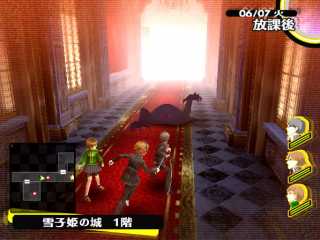
Part of this is because of the Social Link feature, which essentially turns cutscenes into some type of in-game reward. Not that there is anything wrong with this. While in theory, it sounds like a very monetary process (turning characters into mere gameplay rewards), it does exactly the opposite: it gives otherwise rather one-note characters very compelling back stories. For instance, Nanako goes from an independent yet otherwise typical child to upset over how Dojima handles her; Teddie (and, in a way, Rise) transforms from what is largely a cute comic relief character to somebody seriously concerned over their identity (or if he has one in the first place), etc.. Every character goes through this type of transformation, making it very easy to find one you will inevitably like. The only problems with it are from a mechanical standpoint: a lot of it is stat-driven, turning much of the experience into an obtuse meta-game. This can get pretty annoying in a few areas, especially given some of the limits it presents (progressing only one Social Link at a time being the least enjoyable of them). Still, these are minor complaints against an otherwise superb way of developing the game’s large cast.
Not that the cast necessarily needs support; the characters are perfectly fine on their own. It’s hard not to find a great character in the game: Kanji is over the top and violent, Naoto helps a lot with the case (although not so much near the end) in a precise and forceful yet collected manner, etc. Even characters outside your party add a lot to the experience, whether you consider the various Social Link characters or the many quirky teachers populating Yasogami High School. Part of what makes these characters so memorable are the situations presented to them, such as the Cultural Festival and the preceding field trip. Yet what truly makes the characters as great as they are is the voice acting. On its own, the writing can be mildly funny, yet the delivery is what makes a lot of the moments as great as they are. This is no surprise, as Persona 4 sports a large ensemble of great voice actors. From Laura Bailey to Johnny Yong Bosch, Atlus spared no expense when it came to the voice work. In some ways, it feels exactly like an anime.
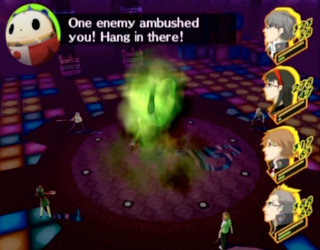
The anime cutscenes have a lot to do with this. On a technical level, these cutscenes are very successful, if not entirely perfect. Clearly, a lot of work was put into these cutscenes, as the animation is fluid and the scenes are fairly detailed. In some areas, characters can appear off-model, and the colors can have some funny saturation, but for the most part, the effort put into them pays off. On an artistic level, though, it is much harder to find fault with them. Each one simply exudes style, even as soon as the game begins. It looks like an iPod commercial mixed with an anime. In fact, these cutscenes go a long way toward making the game feel like an anime. The only place this isn’t true is in length; these cutscenes appear very rarely, last only a minute each, and are oddly clustered at several points in the story.
Outside these cutscenes, though, the game still looks great. Cutscenes can do great things with the camera when they want to; character portraits are detailed and varied, even going so far as to blink at varying speeds; and Teddie has visible fur on him, something not even many games on modern consoles accomplish. The only real flaws come from how utterly generic a lot of the faces on models can be. Even though they are capable of emoting, it’s hard to view them as anything other than utterly generic anime faces completely devoid of any personality. Fortunately, Atlus finds two ways to make this flaw irrelevant. First, the camera is most often pulled away from the characters, making it difficult to see the details on people’s faces. Second, in situations where this is just not possible, characters are given glasses to make them look more distinctive (even if, oddly enough, all the glasses are exactly the same).
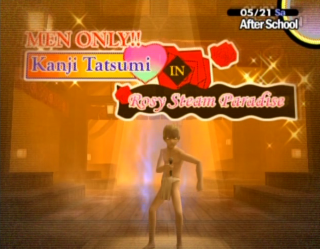
This is most relevant in the battle system, which makes the most of its various elements to create a fun, engaging experience. The battle system plays similarly to many other Atlus RPGs, meaning magic is key to winning battles. Each enemy has its own set of elemental strengths and weaknesses, and it is important to keep track of these (as well as your own) to come out of battle victorious. While it can handle itself in a lot of situations (this is particularly true of on AI commands), many battles require that you pay attention in order to succeed; after all, the wrong Persona/party configuration can easily lead to a quick defeat (especially since the protagonist’s death results in an automatic game over). It is important to note that this element of strategy only applies to the battles themselves; tangential elements, such as weapons or accessories, carry none of this strategy, since it is entirely possible to make it through the entire game on the same accessory. Perhaps it is for this reason that the battles themselves are not the primary source of difficulty for Persona 4.
That honor goes to the dungeons. Although not at first, the dungeons eventually become incredibly long, sprawling ten large floors minimum. (In fact, this is why the early portions of the game are so incredibly easy.) Because of the numerous encounters within these dungeons, SP drains very quickly, leaving you with very little with which to finish the boss. Obviously, this becomes an issue very quickly, especially since these bosses are challenging even at full strength. They require your utmost attention, making them that much more rewarding when you finally take them down. True, it is possible to exit a dungeon at will anytime, but this wastes time, and every dungeon must be finished within a certain number of days before game over.
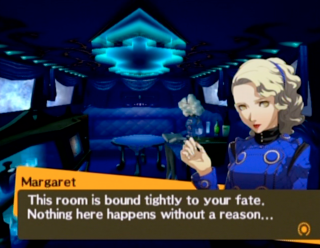
Another reason you may not wish to waste time is because of the myriad activities awaiting you outside the Midnight Channel. A lot of them can only be accessed at certain times (yet, conversely, specific points in the game are devoid of any of these activities), and the sheer volume of them (along with their tendency to explode in number at key points in the plot) makes a New Game + absolutely necessary to get the most out of the game. Unfortunately, though, the quality from activity to activity can vary greatly. For instance, while side quests are largely worth doing, given the decent rewards in terms of effort put into them, they are not very compelling. The overwhelming majority of them are simple fetch quests that require grinding enemies in some random dungeon under very specific conditions until one of them drops the required item. Fishing does not get off much better, given the lack of feedback and overly strong presence of luck in determining if you catch a fish.
One of the more prevalent activities is the occasional jump into school life. It goes without saying that despite the game’s steadfast desire for having as strong a Japanese atmosphere as possible, these moments will universally feel like a typical school experience; if you enjoyed your school experiences, there’s a good chance you will enjoy these ones. You will take tests, answer questions in class, study, etc. A lot of these questions, while dealing with things any school would teach, often dabble in obscure knowledge that no doubt requires the use of an online guide to answer correctly. Although studying (both as the in-game activity and as you studying previous questions) is necessary to achieve success on later exams, it is of no help in answering every day school questions. Fortunately, though, the rewards for these questions are minor enough that they are not necessary for a perfect game, meaning they can either be mildly annoying (for an incorrect answer) or somewhat rewarding (for a correct answer).
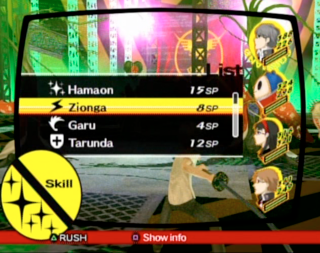
Yet one of the more gratifying (and necessary) side activities is Persona fusion. After battle, it is not uncommon for mini-games to arise which will award the protagonist with another Persona. (The protagonist is the only character capable of using multiple Personae, and as this reduces clutter while emphasizing strategy, it is ultimately for the best). More often than not, they are used in fusion, since leveling them traditionally is too much effort for too little reward. Unfortunately, this can, at times, describe how fusion itself works, given how confusing the ordeal is. The game does its best to inform you of how fusion mechanics work (the manual even comes with a chart detailing this very thing), but they are still quite difficult to comprehend. In that respect, it is generally best to let the game handle the behind-the-scenes workings.
Though this is not to say that everything about the process is confusing. Generally, ability inheritance is straightforward, given its strict adherence to the aforementioned weakness system. In fact, this is where the system works best: the right combination of abilities, bonus EXP, and other specific conditions can result in some incredibly powerful Personae that end up being a lot of fun to use. The only downside to this aspect of the system is how limited the options become at the end of the game. Still, this is a minor complaint to levy against a system that is generally very complex yet still well built.
Given that this game has spawned its own sequel, manga, anime, novel, movie, magazine, stage adaptation, and so much more, it is safe to say that Shin Megami Tensei: Persona 4 is one of Atlus’ more popular titles, and it is not hard to see why.The story is incredibly well thought out with many fleshed out characters, the battles manage to be engaging throughout while somehow relating to the story in a meaningful way, and it makes the most out of the aging hardware that was the Playstation 2. True, it has some minor issues, but these do little to diminish the overall product. In fact, it is difficult to think of other RPGs that do what Persona 4 does better.
